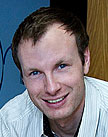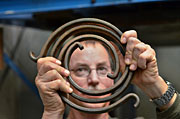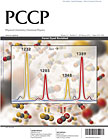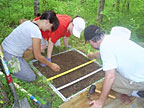- Number 359 |
- March 26, 2012
-
PPPL delivers plasma source for new Berkeley Lab accelerator
Researchers are eager to study this substance, which is rarely seen on Earth but common throughout the universe. Warm dense matter can be found in the molten core of giant planets like Jupiter, and in the preliminary stages of fusion, a process that powers the sun and stars. Such matter intrigues physicists studying the cosmos and scientists including those at PPPL who are seeking to harness fusion to produce electric power.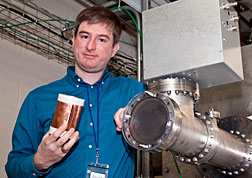 Scientists at DOE’s Princeton Plasma Physics Laboratory (PPPL) have designed and delivered a crucial component for a device that can heat a spot of foil to 30,000 degrees Centigrade in less than a billionth of a second. The part will complete a linear accelerator that researchers at the Lawrence Berkeley National Laboratory are using to create a superheated state called “warm dense matter.”
Scientists at DOE’s Princeton Plasma Physics Laboratory (PPPL) have designed and delivered a crucial component for a device that can heat a spot of foil to 30,000 degrees Centigrade in less than a billionth of a second. The part will complete a linear accelerator that researchers at the Lawrence Berkeley National Laboratory are using to create a superheated state called “warm dense matter.”
-
Toppling Raman shift in supercritical carbon dioxide
Just as a wine glass vibrates and sometimes breaks when a diva sings the right note, carbon dioxide vibrates when light or heat serenades it. When it vibrates, the chemical compound exhibits a vibrational puzzle known as Fermi resonance, first recognized in carbon dioxide and explained by Enrico Fermi in 1931.
Now, researchers studying geologic carbon storage have learned a bit more about the nature of the Fermi resonance in carbon dioxide. This new knowledge can ultimately help scientists interpret spectral lines in complex environments and therefore better understand details in chemical reactions. -
FACE harvest reveals soil carbon storage
Elevated carbon dioxide concentrations can increase carbon storage in the soil, according to results from a 12-year carbon dioxide-enrichment experiment at DOE's Oak Ridge National Laboratory.
The increased storage of carbon in soil could help to slow down rising atmospheric carbon dioxide concentrations.
The Department of Energy-sponsored free-air carbon dioxide-enrichment, or FACE, experiment officially ended in 2009. The conclusion and final harvest of the ORNL FACE experiment provided researchers with the unique opportunity to cut down entire trees and to dig in the soil to quantify the effects of elevated carbon dioxide concentrations on plant and soil carbon. -
Nano-size particles show big potential
Sometimes bigger isn’t better.
Researchers at DOE's Savannah River National Laboratory have successfully shown that they can replace useful little particles of monosodium titanate (MST) with even tinier nano-sized particles, making them even more useful for a variety of applications.
MST is an ion exchange material used to decontaminate radioactive and industrial wastewater solutions, and has been shown to be an effective way to deliver metals into living cells for some types of medical treatment. Typically, MST, and a modified form known as mMST developed by SRNL and Sandia National Laboratories, are in the form of fine powders, spherically-shaped particles about 1 to 10 microns in diameter (a micron is one-millionth of a meter).
